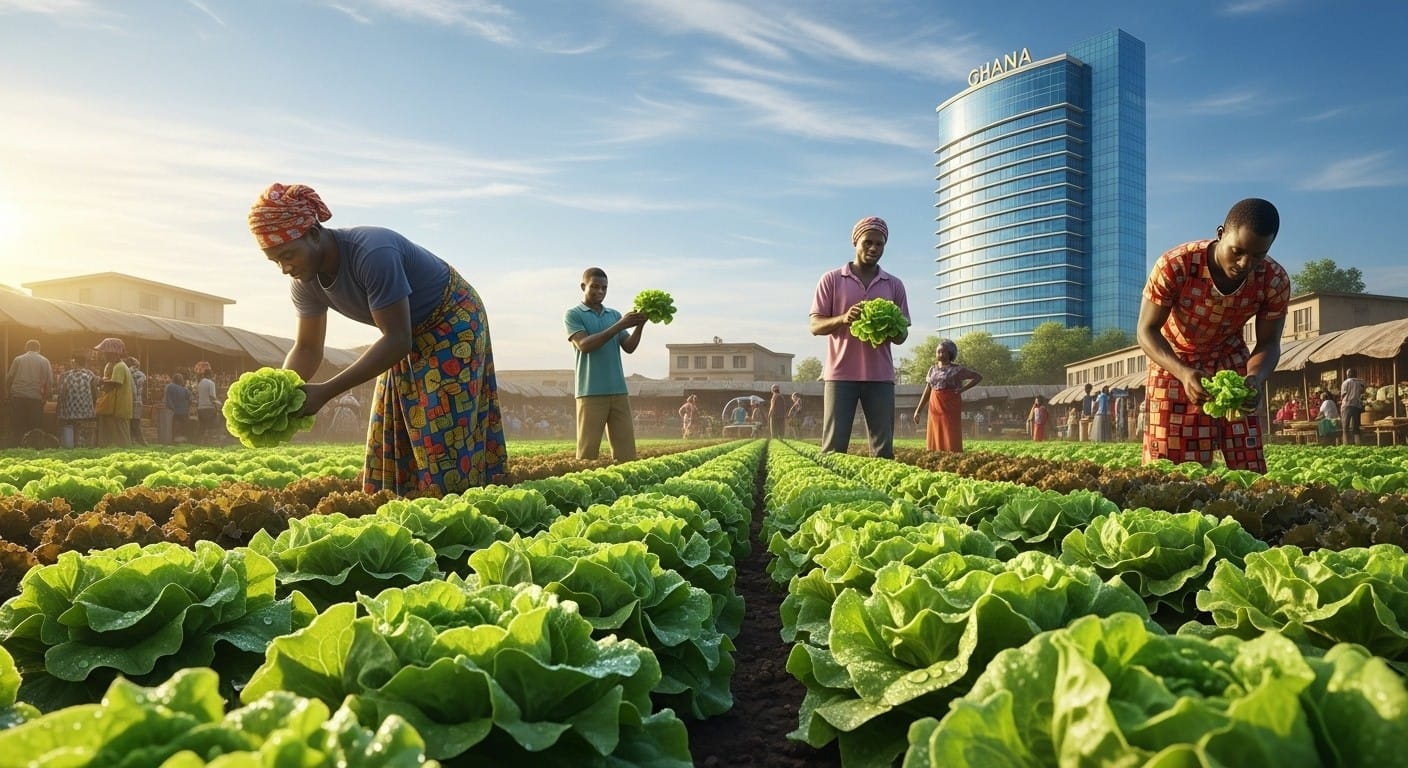A Complete Guide to Profitable Lettuce Farming in Ghana: Growing for Urban Markets & Hotels
Ghana’s bustling cities, like Kumasi and Accra, have a growing appetite for fresh, exotic vegetables, particularly lettuce. This demand from households, restaurants, and hotels presents a significant opportunity for savvy entrepreneurs. While some farmers perceive the venture as challenging, research confirms that lettuce farming can be a highly profitable business, serving as a powerful engine for job creation and economic growth. This guide breaks down how to start a profitable lettuce farming operation in Ghana, using data-backed insights to help you navigate the path to success.
Why Lettuce Farming in Ghana is a Lucrative Venture
Urban vegetable production is crucial for food security and provides a steady income for many. Exotic vegetables like lettuce, which are not native to Ghana, often command high prices in city markets. Research conducted in the Kumasi metropolis highlights several key points:
- High Profit Margins: A study published in the Journal of Global Entrepreneurship Research found that lettuce farming is the most profitable among several exotic vegetable production systems.
- Strong Market Demand: Over 90% of the lettuce consumed in major cities like Accra is supplied by urban producers, catering to a vast market of street food vendors, canteens, and restaurants.
- Quick Returns: Compared to other agricultural ventures, vegetable farming offers quick returns on investment, making it an attractive business for entrepreneurs with limited start-up capital.
Is Lettuce Farming Truly Profitable? A Look at the Numbers
The most critical question for any entrepreneur is about profitability. The research confirms that exotic vegetable farming is a profitable venture. For entrepreneurs focused on growing Lettuce Farming for Urban Markets markets and hotels, understanding the potential returns is key. The study found that cultivating lettuce as a sole crop yielded the highest profit margin.
Below is a simplified breakdown of the average costs and revenues per acre for sole lettuce Lettuce Farming in Ghana Kumasi, Ghana, demonstrating its strong financial viability.
Estimated Profitability of Sole Lettuce Farming (Per Acre)
| Metric | Average Amount (in Ghana Cedis – Gh¢) | Description |
|---|---|---|
| Total Revenue | Gh¢ 2,292.80 | Total income generated from selling the lettuce harvest. |
| Total Variable Costs | Gh¢ 658.49 | Costs that change with production level, such as seeds, fertilizer, and labor. |
| Total Fixed Costs | Gh¢ 6.62 | Costs that remain constant, such as rent or depreciation of tools. |
| Total Production Cost | Gh¢ 665.11 | The sum of all variable and fixed costs. |
| Net Margin (Profit) | Gh¢ 1,627.69 | The final profit after all costs are subtracted from revenue. |
| Net Margin Ratio | 71% | This means for every cedi of revenue, 71% is pure profit, making it a highly efficient business. |
A Step-by-Step Guide for Entrepreneurs
Launching a successful farm requires careful planning. This complete step-by-step guide is designed to help you establish a thriving lettuce farming business in Ghana.
Step 1: Understand the Market and Your Role
The typical urban vegetable farmer in Ghana is a male, around 37 years old, cultivating on a small plot of land (average 1.7 acres). While many do it as their main occupation, you can start small. Your primary customers will likely be market women, who act as intermediaries, buying in bulk for fast-food sellers and restaurants. The study shows that 86% of farmers sell through this channel.
Step 2: Plan Your Production System
While mixed cropping (growing multiple vegetables together) is common, research proves that focusing on a single crop can be more profitable. Sole lettuce cultivation offers the highest net margin (71%). Plan your farm layout to maximize space and efficiency for lettuce production.
Step 3: Secure Land and Manage Tenure
Access to land is a major challenge in urban areas. Farmers often face tenure insecurity. Explore options for long-term leases or seek land in peri-urban areas where it may be more available and affordable. Start with a manageable plot size, such as the average of 1.7 acres, and plan for expansion.
Step 4: Secure Funding and Manage Finances
Access to credit is a critical factor for success. Funding allows you to purchase high-quality seeds, fertilizers, and irrigation equipment, and to hire necessary labor. Approach financial institutions with a solid Lettuce Farming Business Plan outlining your expected costs and revenues based on the data provided above.
Step 5: Develop Your Marketing and Sales Strategy
While market women are the dominant sales outlet, direct sales to hotels, restaurants, and individual consumers can potentially increase your profit margins by cutting out the middleman. Build relationships with local businesses to establish a consistent demand for your high-quality lettuce.
Key Factors to Maximize Your Farm’s Profitability
To truly succeed and run a profitable lettuce farm in Ghana, entrepreneurs should focus on several key drivers of success identified by the research.
- Experience Matters: Farmers with more experience tend to be more profitable. As you gain experience, you learn to incorporate improved technologies and better manage your crops, leading to higher yields and better returns.
- Education and Knowledge: A higher level of formal education positively impacts profitability. Educated farmers are often better at adopting new techniques, managing finances, and making informed business decisions.
- Access to Credit: Having access to loans is a game-changer. It enables you to invest in essential inputs and technologies, directly boosting your farm’s productivity and profitability.
- Household Labor: Leveraging family labor can significantly reduce your operational costs. The study found a positive link between household size and profitability, as family members can supplement or replace hired labor.
Overcoming Common Challenges in Lettuce Farming
Every business has its hurdles. The research identified the top three constraints faced by urban vegetable farmers in Ghana. Being prepared for them is half the battle won.
- High Cost of Inputs: The cost of quality seeds, fertilizers, and pest control can be high. Mitigate this by sourcing from reputable suppliers in bulk or forming a cooperative with other farmers to get better prices.
- Land Tenure Insecurity: The risk of losing farmland to urban development is real. Prioritize securing long-term lease agreements or purchasing land if possible to ensure the stability of your business.
- High Cost of Irrigation: Lettuce requires consistent watering, and the cost of irrigation can be substantial, especially during dry periods. Invest in efficient irrigation systems like drip irrigation to conserve water and reduce costs over the long term.
In conclusion, lettuce farming in Ghana is more than just a means of subsistence; it is a viable and highly profitable business opportunity. By understanding the market, managing costs effectively, and focusing on the key drivers of profitability, entrepreneurs can build a successful enterprise that caters to the growing urban demand. By following this complete step-by-step guide for entrepreneurs, you are well-equipped to turn a small plot of land into a thriving source of income and contribute to Ghana’s food security.











